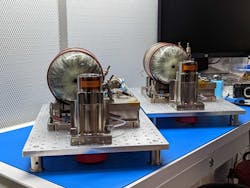Phase Four unveils iodine-based thruster propellant for LEO constellations
EL SEGUNDO, Calif., - Phase Four in El Segundo, Calif., has announced that it will expand its Maxwell turn-key plasma propulsion line and offer satellite manufacturers a high-performance engine using an inexpensive, domestically sourced iodine-based propellant. Max-V leverages the Maxwell Block 2 engine's architecture and builds on the radio-frequency thruster's propellant agnostic capabilities.
Phase Four's Maxwell Block 1 engine gained flight heritage in early 2021. Maxwell Block 2 engine deliveries began earlier this year. With double digit commercial flight units delivered, the company is now focusing on its Max-V development effort. Maxwell's new chassis-style design enables on-ramping of improvements in the core areas of the thruster, power electronics and propellant subsystems.
"Legacy electric propulsion systems are tied to noble gases like xenon and krypton," said Phase Four CEO, Beau Jarvis. "These noble gases, while high performing, are largely sourced outside of the United States in China, Russia and Ukraine. The US has no real control over this supply chain, which is subject to high price volatility and recent severe supply issues." Phase Four board member, former NASA Administrator Jim Bridenstine observed, "This year we've seen xenon prices spike to over $30,000 per kilogram. This is cost prohibitive for both commercial and government satellite constellations in low Earth orbit." Bridenstine continued, "The US is the world's third largest iodine producer, and my home state of Oklahoma leads the way in domestic production. With Max-V, we can ensure a fully domestic supply chain and readily accessible low cost propellant."
Max-V is anticipated to be available for order in the second half of 2023. The system is designed to operate from 200 Watts to 1.5 kilowatts, and achieve 50 mN thrust, over 1,200 s Isp and deliver over 100 kNs total impulse. Max-V's iodine-based propellant will cost under $400 per kilogram and be incorporated in the purchase price. Max-V's form factor is similar to Phase Four's current Maxwell Block 2 engine. The system will ship fully fueled, ready for installation and will require no ground fueling operations prior to launch.
